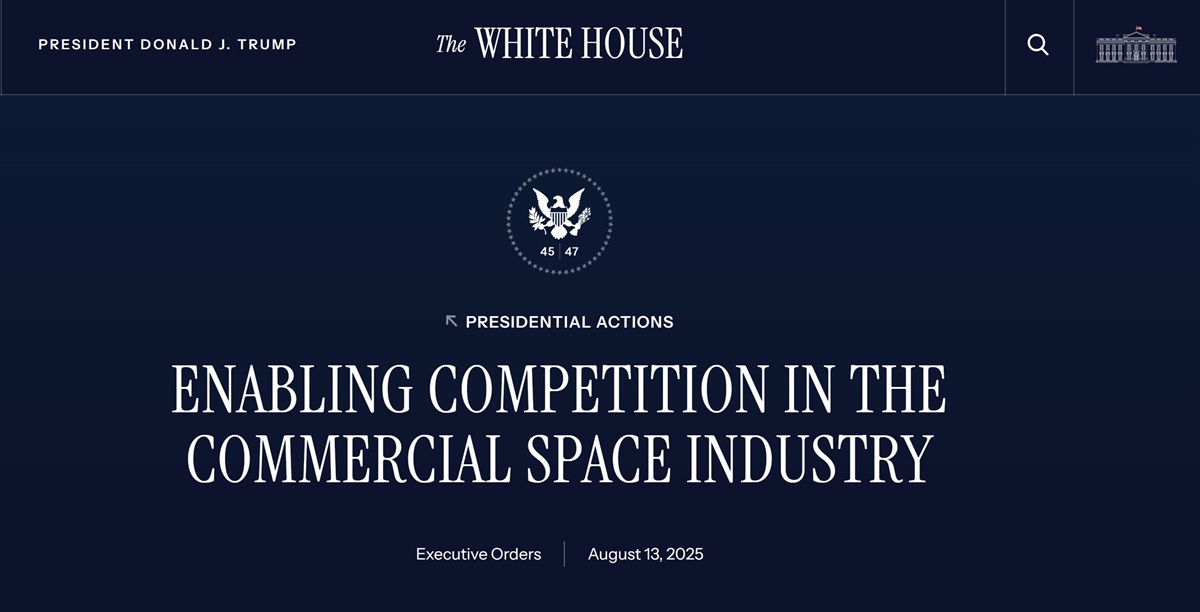In a move set to redefine the trajectory of America’s commercial space sector, President Donald J. Trump on Wednesday signed a landmark Executive Order (EO) titled “Enabling Competition in the Commercial Space Industry,” aimed at removing regulatory barriers and ensuring the United States maintains its leadership as the global powerhouse in space technology and exploration.
With this Executive Order, the Trump administration intends to slash bureaucratic red tape that has long impeded new entrants and slowed the development of cutting-edge space businesses in the U.S., boosting both the pace and scale of commercial space launches as the nation races to outpace foreign adversaries in space innovation.
“This Executive Order takes a sledgehammer to outdated, overly complex licensing rules and environmental reviews that have frustrated entrepreneurs for years,” President Trump stated at a White House ceremony attended by key members of his cabinet and top space industry officials. “We’re making it clear: America will lead the commercial space revolution.”
Key Provisions to Unleash Industry Growth
The expansive EO directs multiple federal agencies, including the Departments of Transportation, Commerce, and Defense, alongside NASA, to comprehensively review and streamline regulations that have hampered new developments in space technologies and the construction of next-generation spaceports across the country.
Highlights of the Executive Order include:
Streamlined Launch and Reentry Approvals: The Secretary of Transportation is tasked with expediting or eliminating duplicative environmental and regulatory reviews for launch and reentry licenses, making it far easier and faster for commercial operators to get their rockets and projects off the ground.
Regulatory Reform: Outdated and redundant rules on launch and reentry vehicles will be eliminated. This step aims to open the doors for innovative companies—both established giants and promising startups keen to break into the burgeoning NewSpace market.
Spaceport Infrastructure Growth: Recognizing the challenges posed by the Coastal Zone Management Act (CZMA), the order instructs agencies to investigate whether state-level processes under the CZMA unnecessarily limit or delay spaceport construction, and to align these with federal priorities.
Accelerated Spaceport Development: The Departments of Defense, Transportation, and NASA are told to synchronize and simplify their overlapping review regimes, clearing the path for faster expansion of U.S. spaceports essential to the growing launch marketplace.
Support for Novel Space Activities: The EO calls for the creation of a streamlined authorization framework for novel activities—such as in-space manufacturing and orbital refueling—that do not fit neatly into current legal structures. This initiative aims to keep U.S. companies at the forefront of new space-based industries with vast commercial potential.
Key Appointments to Advance Reform: The Department of Transportation gains a new adviser dedicated to innovation and deregulation in the space sector, and the FAA will now have an Associate Administrator for Commercial Space Transportation solely focused on regulatory reform and industry support.
Elevating Space Commerce: The Office of Space Commerce is set to be raised in stature within the Department of Commerce, bolstering its role in advancing the commercial space economy.
Industry Voices Applaud the Change
U.S. Transportation Secretary and acting NASA Administrator Sean Duffy, who stood beside President Trump for the executive signing, lauded the overhaul, “People think the Department of Transportation is just about planes, trains, and automobiles—but we have a critical role to play in unlocking the final frontier. By slashing red tape tying up spaceport construction, streamlining launch licenses so they can occur at scale, and creating high-level space positions in government, we can unleash the next wave of innovation. At NASA, this means continuing to work with commercial space companies and improving our spaceports’ ability to launch,” said Duffy. “Thanks to the leadership of President Trump, we will enable American space competitiveness and superiority for decades to come. I look forward to leveraging my dual role at DOT and NASA to make this dream a reality.”
FAA Administrator Bryan Bedford also weighed in, “This order safely removes regulatory barriers so that U.S. companies can dominate commercial space activities,” Bedford said. “The FAA strongly supports President Trump’s Executive Order to make sure the U.S. leads the growing space economy and continues to lead the world in space transportation and innovation.”
Guarding America’s Leadership in Space
This latest regulatory overhaul builds on several transformative actions from Trump’s first term, including the founding of the U.S. Space Force—the first new military branch in over 70 years—and the rollout of seven Space Policy Directives mandating, among other things, the return of American astronauts to the Moon and the establishment of cybersecurity norms for space assets.
The Trump administration underscores the importance of keeping the United States at the vanguard of space innovation in the face of aggressive international competition:
Modernizing regulations will increase launch cadence and novel activities by 2030.
By making it easier to build and operate spaceports, the U.S. will foster a competitive, investment-friendly environment for private space ventures.
Removing barriers to entry allows smaller, innovative companies to effectively challenge established players, unlocking new technologies and manufacturing opportunities in orbit.
President Trump also referenced his administration’s vision for deeper space exploration, including a renewed drive to send astronauts to Mars.
With this EO, the administration hopes to deliver on its promise of “Making American Leadership in Space Great Again,” ensuring a future where the nation remains the birthplace and testing ground for the next era of spaceflight, advanced manufacturing, satellite technology, and beyond.




